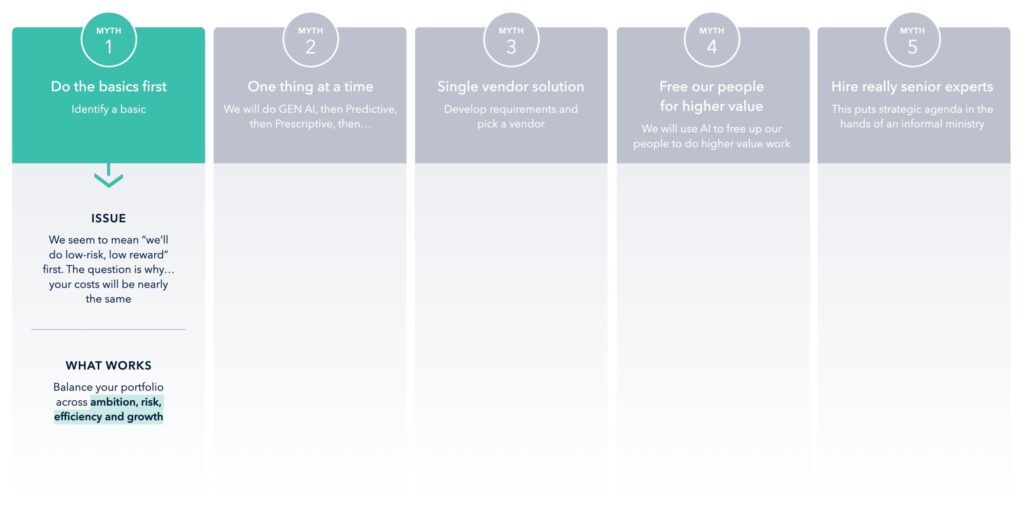There are five common misperceptions regarding the deployment and use of AI that are getting in the way of organizations using it effectively. We’re going to hit them all so here’s an overview of what we’re building towards:

We will address those in this space one at a time. Let’s start with the first one.
Myth #1: We have to get the basics right first
When we hear this from our clients and probe a bit, we learn they’re really saying they want to do something low risk (and low reward) and then spend an extraordinary amount of time and money and focus on doing just that. What you end up with is…very little. The first question business leaders should be asking when this pops into their heads is what’s a “basic” of AI? With the exception of predictive analytics or other discriminative forms being deployed in manufacturing, AI is in its infancy (and those exceptions are barely into their toddler stage). We have no concept of a settled approach or framework for AI. Anyone claiming to have one is either delusional or guessing based on very few, very new data points.
The question, then, is what we are expressing with this statement? The simple answer is risk aversion, also known as fear. This fear morphs into a belief that your company, business unit, functional area, solution area, etc., can back its way into the AI age with little risk and minimal disruption.
You can’t. No one can.
While you can manage the risk associated with something this new, this powerful, and this undefined, you cannot “de-risk” it. And why would you want to? “De-risk” is a responsible-sounding way of saying, “We’re too frightened to do anything.” If that’s the case… Don’t. Do. Anything. It’s okay. You do not have, nor should you, move for the sake of moving. Spending the money and resources to do something “basic” with AI is not much different from doing something transformational. You will learn exponentially more through doing something much more ambitious than doing the basics, with your yield being higher.
Here are some basic steps that will be of high value to your organization:
Accelerate your people’s knowledge of AI and how to apply it to problems.
For the last four decades, business leaders have controlled only some of their strategic agenda; those of us over on the business side of the fence haven’t understood enough about new technologies to drive the agenda and have instead outsourced a significant portion of our business agenda to well-meaning internal and external technology partners. Using this approach with AI will take the most powerful competitive differentiation tool you have ever encountered and guarantee that you are homogenized and commoditized. Your team does not need to become fluent in AI (you need some folks who are, but not everyone). They need to be conversant in different forms (generative vs. discriminative) different manifestations (vision AI, emotion AI, predictive/prescriptive, etc), and different applications outside of your industry.
Immerse your resources into identifying strategic goals – for your domain and independent of AI.
Identifying the areas that need to be addressed to deliver on those goals, framing the problem statements that lead to the most robust solutions, and then identifying the solutions. This step will most likely need a little outside help in the form of consultants or experts who can help challenge both the framing of the problems and the horizon of possibility for the solutions. Balance your solution portfolio across the dimensions of ambition, risk, efficiency, and growth.
Move. Now that we’ve upskilled and immersed our teams into a collaborative solution path, it’s time to start doing.
The first two steps represent taking the time to “think slowly.” The payoff to that is we are now prepared to move faster and with greater efficiency than the current “whack-a-mole” approach being used by most organizations we’ve studied. What you’ll find in steps 1 and 2 is that many of the solutions you create require a common set of AI-enabling technology and because you took the time to engage in Accelerate and Immerse, you have a comprehensive view of what is needed across your portfolio of solutions. You will have the beginnings of the conceptual architecture for your soon to be in existence AI tech stack.
We’re going to talk about that a bit more in a subsequent myth. For now, we’ll leave you with following key takeaways:
- Getting the basics right first is going to hurt you if that means you are going to do safe, small, reactive, low risk-low reward AI initiatives.
- Don’t just do something. Sit there. And think.
- Getting the basics right first will help you if it means accelerating your people’s understanding of AI and helping them to immerse in comprehensive cross-functional solution design.
Stay tuned here for myth number two coming soon. And a free piece of advice for you… Myth number four is going to completely fry your head.

Rik Reppe
leads the Cortico-X Innovation Practice, where he oversees efforts to disrupt the status quo and drive transformative change by breaking traditional molds to envision and create the future.











